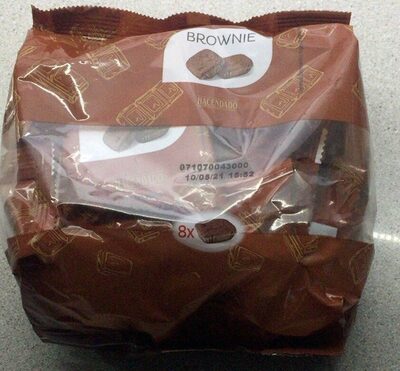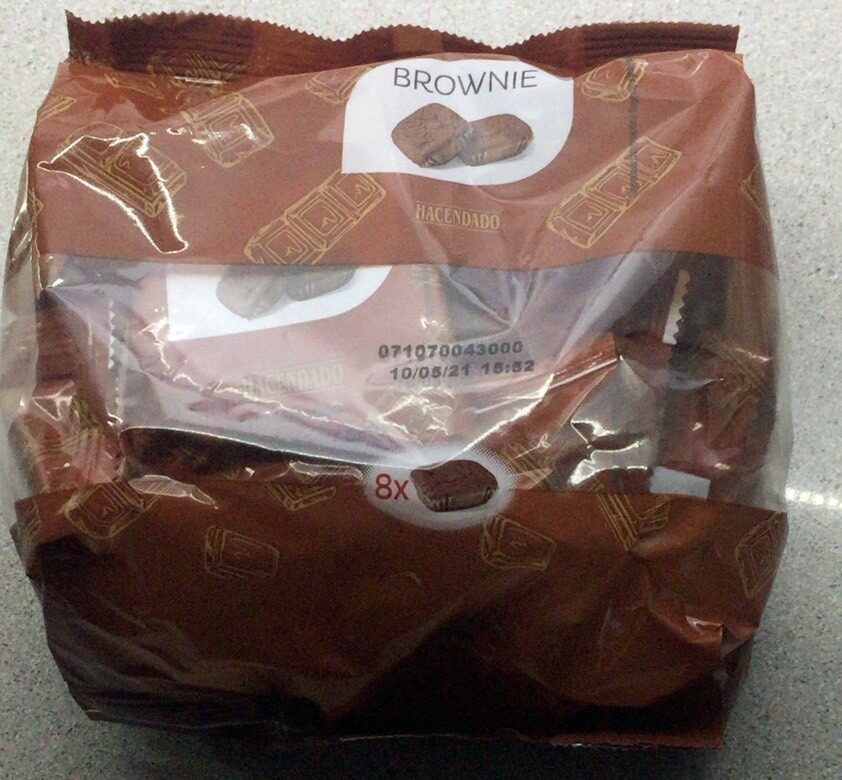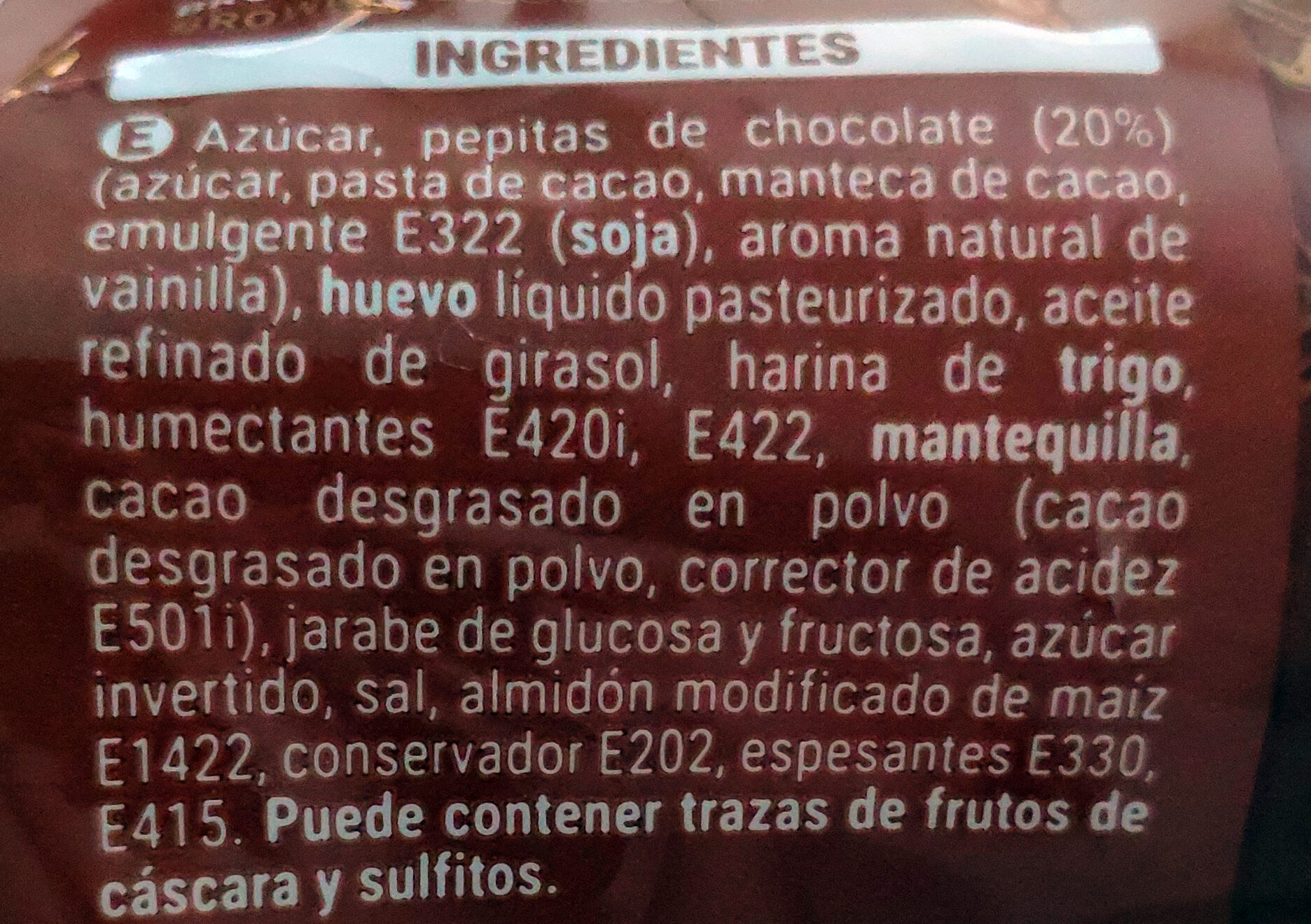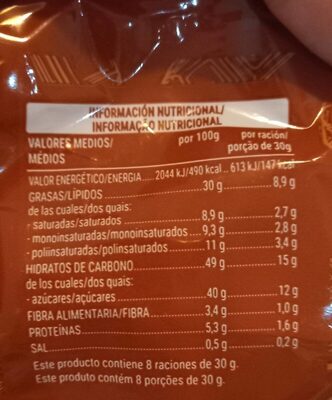Help us make food transparency the norm!
As a non-profit organization, we depend on your donations to continue informing consumers around the world about what they eat.
The food revolution starts with you!
Brownie - Hacendado - 240g
Brownie - Hacendado - 240g
This product page is not complete. You can help to complete it by editing it and adding more data from the photos we have, or by taking more photos using the app for Android or iPhone/iPad. Thank you!
×
Barra-kodea: 8480000016812 (EAN / EAN-13)
Izen arrunta: Brownie bizcocho de chocolate
Kopurua: 240g
Ontziratzea: es:Green dot
Markak: Hacendado
Kategoriak: en:Snacks, en:Sweet snacks, en:Biscuits and cakes, Gozopil, en:Chocolate cakes, en:Brownies
Etiketak, ziurtagiriak, sariak:
en:Green Dot
Manufacturing or processing places: Spain
Saltzen diren herrialdeak: Espainia
Matching with your preferences
Health
Osagaiak
-
29 ingredients
: Azúcar, pepitas de chocolate (20%) (azúcar, pasta de cacao, manteca de cacao, emulgente (E322) (soja), aroma natural de vainilla), huevo liquido pasteurizado, aceite refinado de girasol, harina de trigo, humectantes (E420i, E422), mantequilla, cacao desgrasado en polvo (cacao desgrasado en polvo, corrector de acidez (E501i)), jarabe de glucosa y fructosa, azúcar invertido, sal, almidón modificado de maíz (E1422), conservador (E202), espesantes (E330, E415)Alergenoak: en:Eggs, en:Gluten, en:Soybeans, es:mantequillaAztarnak: en:Nuts, en:Soybeans, en:Sulphur dioxide and sulphites
Food processing
-
Ultra processed foods
Elements that indicate the product is in the 4 - Ultra prozesatutako elikagaiak eta edariak group:
- Gehigarria: E1422
- Gehigarria: E14XX
- Gehigarria: E322
- Gehigarria: E415
- Gehigarria: E420
- Gehigarria: E422 - Glizerina
- Osagaia: Emulsifier
- Osagaia: Flavouring
- Osagaia: Glukosa
- Osagaia: Humectant
- Osagaia: Invert sugar
- Osagaia: Thickener
Food products are classified into 4 groups according to their degree of processing:
- Prozesatu gabeko edo ahalik eta gutxien prozesatutako elikagaiak
- Sukaldaritzako osagaiak prozesatu
- Prozesatutako jakiak
- Ultra processed foods
The determination of the group is based on the category of the product and on the ingredients it contains.
Gehigarriak
-
E1422
Acetylated distarch adipate: Acetylated distarch adipate -E1422-, is a starch that is treated with acetic anhydride and adipic acid anhydride to resist high temperatures. It is used in foods as a bulking agent, stabilizer and a thickener. No acceptable daily intake for human consumption has been determined.Source: Wikipedia (Ingeles)
-
E202
Potassium sorbate: Potassium sorbate is the potassium salt of sorbic acid, chemical formula CH3CH=CH−CH=CH−CO2K. It is a white salt that is very soluble in water -58.2% at 20 °C-. It is primarily used as a food preservative -E number 202-. Potassium sorbate is effective in a variety of applications including food, wine, and personal-care products. While sorbic acid is naturally occurring in some berries, virtually all of the world's production of sorbic acid, from which potassium sorbate is derived, is manufactured synthetically.Source: Wikipedia (Ingeles)
-
E322
Lecithin: Lecithin -UK: , US: , from the Greek lekithos, "egg yolk"- is a generic term to designate any group of yellow-brownish fatty substances occurring in animal and plant tissues, which are amphiphilic – they attract both water and fatty substances -and so are both hydrophilic and lipophilic-, and are used for smoothing food textures, dissolving powders -emulsifying-, homogenizing liquid mixtures, and repelling sticking materials.Lecithins are mixtures of glycerophospholipids including phosphatidylcholine, phosphatidylethanolamine, phosphatidylinositol, phosphatidylserine, and phosphatidic acid.Lecithin was first isolated in 1845 by the French chemist and pharmacist Theodore Gobley. In 1850, he named the phosphatidylcholine lécithine. Gobley originally isolated lecithin from egg yolk—λέκιθος lekithos is "egg yolk" in Ancient Greek—and established the complete chemical formula of phosphatidylcholine in 1874; in between, he had demonstrated the presence of lecithin in a variety of biological matters, including venous blood, in human lungs, bile, human brain tissue, fish eggs, fish roe, and chicken and sheep brain. Lecithin can easily be extracted chemically using solvents such as hexane, ethanol, acetone, petroleum ether, benzene, etc., or extraction can be done mechanically. It is usually available from sources such as soybeans, eggs, milk, marine sources, rapeseed, cottonseed, and sunflower. It has low solubility in water, but is an excellent emulsifier. In aqueous solution, its phospholipids can form either liposomes, bilayer sheets, micelles, or lamellar structures, depending on hydration and temperature. This results in a type of surfactant that usually is classified as amphipathic. Lecithin is sold as a food additive and dietary supplement. In cooking, it is sometimes used as an emulsifier and to prevent sticking, for example in nonstick cooking spray.Source: Wikipedia (Ingeles)
-
E330 - Azido zitriko
Citric acid: Citric acid is a weak organic acid that has the chemical formula C6H8O7. It occurs naturally in citrus fruits. In biochemistry, it is an intermediate in the citric acid cycle, which occurs in the metabolism of all aerobic organisms. More than a million tons of citric acid are manufactured every year. It is used widely as an acidifier, as a flavoring and chelating agent.A citrate is a derivative of citric acid; that is, the salts, esters, and the polyatomic anion found in solution. An example of the former, a salt is trisodium citrate; an ester is triethyl citrate. When part of a salt, the formula of the citrate ion is written as C6H5O3−7 or C3H5O-COO-3−3.Source: Wikipedia (Ingeles)
-
E415
Xanthan gum: Xanthan gum -- is a polysaccharide with many industrial uses, including as a common food additive. It is an effective thickening agent and stabilizer to prevent ingredients from separating. It can be produced from simple sugars using a fermentation process, and derives its name from the species of bacteria used, Xanthomonas campestris.Source: Wikipedia (Ingeles)
-
E420
Sorbitol: Sorbitol --, less commonly known as glucitol --, is a sugar alcohol with a sweet taste which the human body metabolizes slowly. It can be obtained by reduction of glucose, which changes the aldehyde group to a hydroxyl group. Most sorbitol is made from corn syrup, but it is also found in nature, for example in apples, pears, peaches, and prunes. It is converted to fructose by sorbitol-6-phosphate 2-dehydrogenase. Sorbitol is an isomer of mannitol, another sugar alcohol; the two differ only in the orientation of the hydroxyl group on carbon 2. While similar, the two sugar alcohols have very different sources in nature, melting points, and uses.Source: Wikipedia (Ingeles)
-
E420i
Sorbitol: Sorbitol --, less commonly known as glucitol --, is a sugar alcohol with a sweet taste which the human body metabolizes slowly. It can be obtained by reduction of glucose, which changes the aldehyde group to a hydroxyl group. Most sorbitol is made from corn syrup, but it is also found in nature, for example in apples, pears, peaches, and prunes. It is converted to fructose by sorbitol-6-phosphate 2-dehydrogenase. Sorbitol is an isomer of mannitol, another sugar alcohol; the two differ only in the orientation of the hydroxyl group on carbon 2. While similar, the two sugar alcohols have very different sources in nature, melting points, and uses.Source: Wikipedia (Ingeles)
-
E422 - Glizerina
Glycerol: Glycerol -; also called glycerine or glycerin; see spelling differences- is a simple polyol compound. It is a colorless, odorless, viscous liquid that is sweet-tasting and non-toxic. The glycerol backbone is found in all lipids known as triglycerides. It is widely used in the food industry as a sweetener and humectant and in pharmaceutical formulations. Glycerol has three hydroxyl groups that are responsible for its solubility in water and its hygroscopic nature.Source: Wikipedia (Ingeles)
-
E501
Potassium carbonate: Potassium carbonate -K2CO3- is a white salt, which is soluble in water -insoluble in ethanol- and forms a strongly alkaline solution. It can be made as the product of potassium hydroxide's absorbent reaction with carbon dioxide. It is deliquescent, often appearing a damp or wet solid. Potassium carbonate is used in the production of soap and glass.Source: Wikipedia (Ingeles)
-
E501i
Potassium carbonate: Potassium carbonate -K2CO3- is a white salt, which is soluble in water -insoluble in ethanol- and forms a strongly alkaline solution. It can be made as the product of potassium hydroxide's absorbent reaction with carbon dioxide. It is deliquescent, often appearing a damp or wet solid. Potassium carbonate is used in the production of soap and glass.Source: Wikipedia (Ingeles)
Ingredients analysis
-
en:Palm oil free
No ingredients containing palm oil detected
-
en:Non-vegan
Non-vegan ingredients: en:Liquid egg, Gurin
-
en:Vegetarian status unknown
Unrecognized ingredients: en:Invert sugar
-
Details of the analysis of the ingredients
: Azúcar, pepitas de chocolate 20% (azúcar, pasta de cacao, manteca de cacao, emulgente (e322), aroma natural de vainilla), _huevo_ liquido, aceite refinado de girasol, harina de _trigo_, humectantes (e420i, e422), _mantequilla_, cacao desgrasado en polvo (cacao desgrasado en polvo, corrector de acidez (e501i)), jarabe de glucosa y fructosa, azúcar invertido, sal, almidón modificado de maíz (e1422), conservador (e202), espesantes (e330, e415)- Azúcar -> en:sugar - vegan: yes - vegetarian: yes - ciqual_proxy_food_code: 31016 - percent_min: 20 - percent_max: 80
- pepitas de chocolate -> en:chocolate-chunk - vegan: maybe - vegetarian: yes - ciqual_proxy_food_code: 31005 - percent_min: 20 - percent: 20 - percent_max: 20
- azúcar -> en:sugar - vegan: yes - vegetarian: yes - ciqual_proxy_food_code: 31016 - percent_min: 4 - percent_max: 20
- pasta de cacao -> en:cocoa-paste - vegan: yes - vegetarian: yes - ciqual_proxy_food_code: 16030 - percent_min: 0 - percent_max: 10
- manteca de cacao -> en:cocoa-butter - vegan: yes - vegetarian: yes - ciqual_food_code: 16030 - percent_min: 0 - percent_max: 6.66666666666667
- emulgente -> en:emulsifier - percent_min: 0 - percent_max: 5
- e322 -> en:e322 - vegan: maybe - vegetarian: maybe - percent_min: 0 - percent_max: 5
- aroma natural de vainilla -> en:natural-vanilla-flavouring - vegan: yes - vegetarian: yes - percent_min: 0 - percent_max: 4
- _huevo_ liquido -> en:liquid-egg - vegan: no - vegetarian: yes - ciqual_food_code: 22000 - percent_min: 0 - percent_max: 20
- aceite refinado de girasol -> en:refined-sunflower-oil - vegan: yes - vegetarian: yes - from_palm_oil: no - ciqual_food_code: 17440 - percent_min: 0 - percent_max: 20
- harina de _trigo_ -> en:wheat-flour - vegan: yes - vegetarian: yes - ciqual_proxy_food_code: 9410 - percent_min: 0 - percent_max: 20
- humectantes -> en:humectant - percent_min: 0 - percent_max: 15
- e420i -> en:e420i - vegan: yes - vegetarian: yes - percent_min: 0 - percent_max: 15
- e422 -> en:e422 - vegan: maybe - vegetarian: maybe - percent_min: 0 - percent_max: 7.5
- _mantequilla_ -> en:butter - vegan: no - vegetarian: yes - ciqual_proxy_food_code: 16400 - percent_min: 0 - percent_max: 12
- cacao desgrasado en polvo -> en:fat-reduced-cocoa-powder - vegan: yes - vegetarian: yes - ciqual_food_code: 18100 - percent_min: 0 - percent_max: 10
- cacao desgrasado en polvo -> en:fat-reduced-cocoa-powder - vegan: yes - vegetarian: yes - ciqual_food_code: 18100 - percent_min: 0 - percent_max: 10
- corrector de acidez -> en:acidity-regulator - percent_min: 0 - percent_max: 5
- e501i -> en:e501i - vegan: yes - vegetarian: yes - percent_min: 0 - percent_max: 5
- jarabe de glucosa y fructosa -> en:glucose-fructose-syrup - vegan: yes - vegetarian: yes - ciqual_food_code: 31077 - percent_min: 0 - percent_max: 8.57142857142857
- azúcar invertido -> en:invert-sugar - percent_min: 0 - percent_max: 7.5
- sal -> en:salt - vegan: yes - vegetarian: yes - ciqual_food_code: 11058 - percent_min: 0 - percent_max: 0.5
- almidón modificado de maíz -> en:modified-corn-starch - vegan: yes - vegetarian: yes - ciqual_food_code: 9510 - percent_min: 0 - percent_max: 0.5
- e1422 -> en:e1422 - vegan: yes - vegetarian: yes - percent_min: 0 - percent_max: 0.5
- conservador -> en:preservative - percent_min: 0 - percent_max: 0.5
- e202 -> en:e202 - vegan: yes - vegetarian: yes - percent_min: 0 - percent_max: 0.5
- espesantes -> en:thickener - percent_min: 0 - percent_max: 0.5
- e330 -> en:e330 - vegan: yes - vegetarian: yes - percent_min: 0 - percent_max: 0.5
- e415 -> en:e415 - vegan: yes - vegetarian: yes - percent_min: 0 - percent_max: 0.25
Elikadura
-
Bad nutritional quality
⚠ ️Warning: the amount of fruits, vegetables and nuts is not specified on the label, it was estimated from the list of ingredients: 0This product is not considered a beverage for the calculation of the Nutri-Score.
Positive points: 3
- Proteinak: 3 / 5 (balioa: 5.3, rounded value: 5.3)
- Fiber: 3 / 5 (balioa: 3.4, rounded value: 3.4)
- Fruits, vegetables, nuts, and colza/walnut/olive oils: 0 / 5 (balioa: 0, rounded value: 0)
Negative points: 24
- Energia: 6 / 10 (balioa: 2044, rounded value: 2044)
- Azukreak: 8 / 10 (balioa: 40, rounded value: 40)
- Gantz saturatua: 8 / 10 (balioa: 8.9, rounded value: 8.9)
- Sodioa: 2 / 10 (balioa: 200, rounded value: 200)
The points for proteins are not counted because the negative points are greater or equal to 11.
Nutritional score: (24 - 3)
Nutri-Score:
-
Nutrient levels
-
Koipe in high quantity (30%)
What you need to know- A high consumption of fat, especially saturated fats, can raise cholesterol, which increases the risk of heart diseases.
Recommendation: Limit the consumption of fat and saturated fat- Choose products with lower fat and saturated fat content.
-
Gantz-azido ase in high quantity (8.9%)
What you need to know- A high consumption of fat, especially saturated fats, can raise cholesterol, which increases the risk of heart diseases.
Recommendation: Limit the consumption of fat and saturated fat- Choose products with lower fat and saturated fat content.
-
Azukre in high quantity (40%)
What you need to know- A high consumption of sugar can cause weight gain and tooth decay. It also augments the risk of type 2 diabetes and cardio-vascular diseases.
Recommendation: Limit the consumption of sugar and sugary drinks- Sugary drinks (such as sodas, fruit beverages, and fruit juices and nectars) should be limited as much as possible (no more than 1 glass a day).
- Choose products with lower sugar content and reduce the consumption of products with added sugars.
-
Gatz arrunt in moderate quantity (0.5%)
What you need to know- A high consumption of salt (or sodium) can cause raised blood pressure, which can increase the risk of heart disease and stroke.
- Many people who have high blood pressure do not know it, as there are often no symptoms.
- Most people consume too much salt (on average 9 to 12 grams per day), around twice the recommended maximum level of intake.
Recommendation: Limit the consumption of salt and salted food- Reduce the quantity of salt used when cooking, and don't salt again at the table.
- Limit the consumption of salty snacks and choose products with lower salt content.
-
-
Nutrition facts
Nutrition facts As sold
for 100 g / 100 mlAs sold
per serving (30g)Compared to: en:Brownies Energia 2.044 kj
(490 kcal)613 kj
(147 kcal)+% 18 Koipe 30 g 9 g +% 36 Gantz-azido ase 8,9 g 2,67 g +% 35 Gantz-azido monoasegabe 9,3 g 2,79 g Polyunsaturated fat 11 g 3,3 g Carbohydrates 49 g 14,7 g -% 1 Azukre 40 g 12 g +% 16 Fiber 3,4 g 1,02 g -% 25 Proteina 5,3 g 1,59 g +% 2 Gatz arrunt 0,5 g 0,15 g +% 19 Fruits‚ vegetables‚ nuts and rapeseed‚ walnut and olive oils (estimate from ingredients list analysis) 0 % 0 %
Ingurumena
-
Eco-Score D - High environmental impact
The Eco-Score is an experimental score that summarizes the environmental impacts of food products.→ The Eco-Score was initially developped for France and it is being extended to other European countries. The Eco-Score formula is subject to change as it is regularly improved to make it more precise and better suited to each country.Life cycle analysis
-
Average impact of products of the same category: C (Score: 44/100)
Kategoria: Brownie (chocolate cake)
Kategoria: Brownie (chocolate cake)
- PEF environmental score: 0.66 (the lower the score, the lower the impact)
- including impact on climate change: 7.28 kg CO2 eq/kg of product
Stage Impact Agriculture
61.5 %Processing
32.6 %Ontziratzea
2.9 %Transportation
2.4 %Distribution
0.7 %Consumption
0.0 %
Bonuses and maluses
-
Missing origins of ingredients information
Malus: -5
⚠ ️ The origins of the ingredients of this product are not indicated.
If they are indicated on the packaging, you can modify the product sheet and add them.
If you are the manufacturer of this product, you can send us the information with our free platform for producers.
-
Missing packaging information for this product
Malus: -15
⚠ ️ The information about the packaging of this product is not filled in.⚠ ️ For a more precise calculation of the Eco-Score, you can modify the product page and add them.
If you are the manufacturer of this product, you can send us the information with our free platform for producers.
Eco-Score for this product
-
Impact for this product: D (Score: 24/100)
Produktua: Brownie - Hacendado - 240g
Life cycle analysis score: 44
Sum of bonuses and maluses: -20
Final score: 24/100
-
Carbon footprint
-
Equal to driving 3.8 km in a petrol car
728 g CO² per 100g of product
The carbon emission figure comes from ADEME's Agribalyse database, for the category: Brownie (chocolate cake) (Source: ADEME Agribalyse Database)
Stage Impact Agriculture
39.4 %Processing
54.0 %Ontziratzea
4.0 %Transportation
2.4 %Distribution
0.3 %Consumption
0.0 %
Ontziratzea
-
Missing packaging information for this product
⚠ ️ The information about the packaging of this product is not filled in.Take a photo of the recycling information Take a photo of the recycling information
Transportation
-
Origins of ingredients
Missing origins of ingredients information
⚠ ️ The origins of the ingredients of this product are not indicated.
If they are indicated on the packaging, you can modify the product sheet and add them.
If you are the manufacturer of this product, you can send us the information with our free platform for producers.Add the origins of ingredients for this product Add the origins of ingredients for this product
Report a problem
-
Incomplete or incorrect information?
Category, labels, ingredients, allergens, nutritional information, photos etc.
If the information does not match the information on the packaging, please complete or correct it. Open Food Facts is a collaborative database, and every contribution is useful for all.
Datuen iturria
Product added on by kiliweb
Last edit of product page on by roboto-app.
Produktuaren orria -gatik editatua alia, ecoscore-impact-estimator, inf, openfoodfacts-contributors, yuka.sY2b0xO6T85zoF3NwEKvlk1fCMaEshT1aCflq1CMmfeQAsTrUet25dWgbqo, yuka.sY2b0xO6T85zoF3NwEKvlkprVtrji2LLLBbUlGuG4OqyP53PPNwiy5Oibqo.












